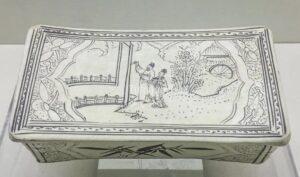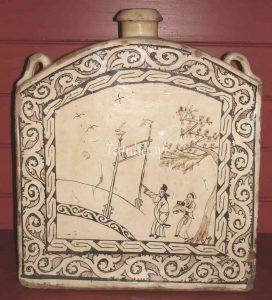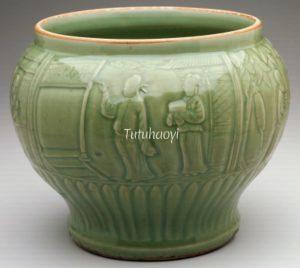Sima Xiangru inscribing on the bridge gateway
相如题桥
© Tutuhaoyi.com owns the copyright of the description content for the images attached. Quoting all or part of the description content on this page is permitted ONLY IF ‘Tutuhaoyi.com’ is clearly acknowledged anywhere your quote is produced unless stated otherwise. (本页描述内容版权归Tutuhaoyi.com所有,转发或引用需注明 “Tutuhaoyi.com”, 侵权必究, 已注开源信息的条目除外。)
‘Sima Xiangru Inscribing on the Bridge Gateway (相如题桥)’ was a popular theme in theatre from at least the Song (960–1279) through to the Qing (1644–1911) dynasty. Sima Xiangru (司马相如) was a Western Han (202 BCE – 8 CE) scholar unsuccessful in making a career in civil services. However, Wang Ji, the magistrate of Linqiong county, was impressed by his dazzling talents and invited him to live in his house as a guest.
One day, a rich local businessman, Zhuo Wangsun (卓王孙), held a house party for Wang and Sima, at which Sima played the qin zither. Zhuo’s recently-widowed daughter, Wenjun (文君), heard the music and was fascinated by Sima’s performance as well as his genteel manner and bearing. The two fell in love and she eloped with him. Mortified, Zhuo Wangsun refused to support the couple and the poverty-stricken lovers had to earn their living by running a wine-shop by the roadside.
One autumn day, encouraged by his wife, Sima made up his mind to leave home to seek his fortune in the capital, Chang’an. Wenjun went to see him off at the Bridge of ‘Ascending to the Realm of Immortals’ (昇仙桥) on the outskirts. When he made farewell to his wife, Sima vowed that he would not cross the bridge again unless he did so riding in a grand carriage drawn by four horses.
Sure enough, his ambition was realised in a few years’ time and he enjoyed a triumphant home-coming ceremony given by the local officials. The anecdote has encouraged generations of young men leaving hometown to seek fortunes in the big world!
Fig 1: square Cizhou-type stoneware pillow, Yuan dynasty (1271–1368), courtesy of the China Cizhou Kiln Museum, China
Fig 2: Longquan ware jar (detail), Yuan dynasty (ca.1320–1368), courtesy of the British Museum, London
Fig 3: square Cizhou-type stoneware wine flask, late Yuan- Early Ming dynasty (c. 1280–1398), courtesy of the British Museum, London
Fig 4-5: celadon jar, 14th century, courtesy of Minneapolis Institute of Art, Minnesota
Fig 6: beaker porcelain vase with underglaze blue decoration (detail), Chongzhen period (1628–44), Ming dynasty, formerly of the Jie Rui Tang Collection
Fig 7: porcelain vase with underglaze blue and overglaze enamelled decoration, Shunzhi period (1644–61), Qing dynasty, courtesy of Shanghai Museum, China






